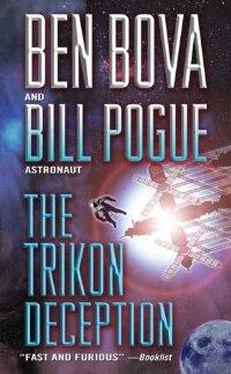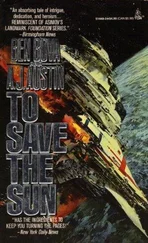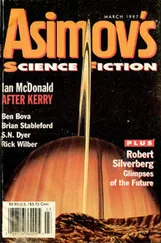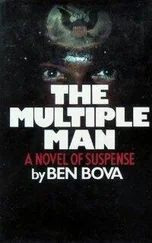The liquid hydrogen was removed by a clever pumping device conceived by a former Apollo astronaut working for Trikon as a consultant. The liquid oxygen was simply heated by sunlight until it turned into its gaseous, breathable state.
On subsequent shuttle flights, teams of mission specialists brought up the office facilities, compartments, galleys, and workstation equipment; they installed them in the larger of the ET’s two sections, the huge volume that had contained liquid hydrogen fuel. The former liquid oxygen volume, located at the tapered front end of the tank, was converted into an observation blister. The ET was then attached to the trailing edge of Trikon Station’s skeleton, its own internal tunnel an extension of the connecting tunnel that ran the length of the station’s main horizontal truss.
The Martians themselves were payload specialists from several different scientific disciplines. Their workdays were devoted to Mars-related experiments. A meteorologist studied Martian weather patterns using data gathered by satellites orbiting the red planet. Two biochemists searched for signs of life in soil returned from Mars in the US-USSR robot probes landed on the Martian surface a few years earlier. A geologist examined rocks for clues to Mars’s distant past. All the while, the participants were tested, probed, and analyzed by physicians and psychologists on the ground.
Kurt Jaeckle was the leader of the Mars Project. An internationally renowned astronomer on permanent leave from a professorship at Johns Hopkins University, he had defeated an equally famous French exobiologist in the contest for project leader. Then, through shrewd negotiating, he had arranged for the Mars module to be attached to the privately owned Trikon Station rather than to Freedom, the United States’ space station. The main reason for the switch was that Jaeckle had secretly cooked up a live-television contract with TBC and the Canadian Broadcasting Company.
Jaeckle swam down the Mars module’s internal tunnel, heading for his own office. The tunnel had been a hasty design addition, its purpose to provide all station personnel with direct access to the module’s elaborate observation blister without chance encounters with the segregated Martians. The tunnel was two meters in diameter, its flat gray walls a dim contrast to the brighter Trikon connecting tunnel. Several doors along its length opened into the module’s working and living areas.
Jaeckle entered through the first access door and directed himself across the spacious open expanse of the module’s laboratory section toward his office, located in the fore starboard corner. All of the Martians were busily at work and only one, Russell Cramer, noticed Jaeckle’s entry. Cramer stared at Jaeckle from his workstation five meters away. His jowly face was expressionless, but seemed to demand an acknowledgment. Jaeckle obliged with a wave. Cramer, without responding, returned his attention to his microscope.
I must have a word with him, thought Jaeckle. He stopped at his office door and consulted the blister reservation list attached to the bulkhead. Carla Sue Gamble was in the observation blister now. As usual, none of the other Martians had reserved the following hour. Jaeckle wrote his name into the next slot.
Inside his office, Jaeckle powered up his communications console and called TBC headquarters in New York City. As Mars Project head, he was exempt from Trikon’s restrictions on secured communications and had a selection of voice encryption chips at his disposal. The chips broke up the voice transmission into meaningless signals that would be reassembled by another chip at the receiving station. Eavesdropping ham-radio operators would hear nothing but Chinese violins. Jaeckle didn’t often use encryption when talking to TBC, but today the language could become dicey. He pressed a chip into its slot.
The link was shunted from receptionist to secretary to executive secretary and finally to Jared Lewis, the vice president in charge of “Good Morning, World.”
Lewis was angry, his fleshy face blotchy red. Jaeckle was exactly one sentence into his explanation of the morning’s event when Lewis launched into a tirade. He railed about confusion in the control room and about the co-anchor who had taken a break from the set during the live broadcast from space and then could not be located when the transmission abruptly ended.
“You think we like showing an empty chair!” shrieked Lewis. He started ranting about advertising dollars and market share.
Eventually Lewis slowed down and Jaeckle had a chance to talk. He used all of his narrative skills to paint a picture of confusion and horror on the stricken space station.
“Jesus,” said the chastened Lewis. “Hey, maybe we can start the next broadcast with a reenactment. I’ll get one of the segment directors to contact you about it pronto. How is Carla Sue doing?”
“Actually,” said Jaeckle, shifting narrative gears, “I think the mission is beginning to wear on her.”
“You know, it’s funny,” Lewis said. “I was thinking the exact same thing this morning. Those legs. I mean, come on. We’re talking anorexic.”
“I’ve explained the fluid shift several times on the air.”
“Words are words. Pictures are what counts,” said Lewis. “We don’t want people coming away with images of anorexic astronauts.”
“Unfortunately, it cannot be avoided.”
“Maybe if you had someone else,” Lewis suggested. “Someone with a little more heft or a little less fluid shift. Paint a prettier picture for our viewers.”
“There is someone,” Jaeckle said slowly, as if the idea had just entered his mind. “But she isn’t a part of the Mars Project.”
“Hey, there’s nothing in the contract that says your assistant has to be a part of the Mars Project. She could be a Venusian for all I care.”
“I don’t know how Carla Sue would react to being replaced.”
“It’ll a rough business, Kurt.”
“This other one may not even want to be on television.”
“Everybody wants to be on television,” said Lewis. “Who is she?”
“Lorraine Renoir.”
“I like it,” Lewis said. “French?”
“French Canadian, actually. She is the station medical officer.”
“Nice tie-in. She could interest the Canadian audiences. Ratings have been low there. Attractive?”
“Well,” said Jaeckle. “Not anorexic.”
“Talk to her and let me know. Have to run.”
The telelink broke. Jaeckle snapped off his communications console. He felt encouraged, expansive. Talking to TBC always was entertaining, especially since Jared Lewis was so malleable.
Jaeckle propelled himself toward the observation blister up at the tip of the module, a dome of strong and perfectly transparent Lexan. The outer surface of the dome was covered by an aluminum clamshell shield that could be closed to prevent damage from meteoroids or debris. Retracting the shield in different ways offered stunning views of the Earth, the night sky, or both.
Everyone on the station was allowed to use the blister for personal R and R on a reservation basis. In the context of the Mars Project, the blister was more than just a place for quiet solitude or spectacular scenery. Since transit to Mars would entail long stretches of time out of Earth view, project coordinators assigned specific viewing privileges to the two groups. The segregated group was allowed to view only the empty night sky; they never saw the Earth. The other group had no restrictions. Psychologists on the ground were eager to see if the two groups differed in long-term adaptation. Carla Sue Gamble was part of the “free” group.
Jaeckle rapped on the metal hatch of the blister. After a long moment, the bolt slid back and the door opened. There was the Earth, immense, breathtaking, sparkling blue and brilliant white, gliding past beyond the Lexan windows. But Jaeckle barely noticed the spectacular panorama. He focused on Carla Sue, long, lean, and angry. He could tell from the tightness of her lips and the knit in her brow that the delay in unlocking the blister hatch had been carefully calculated.
Читать дальше












